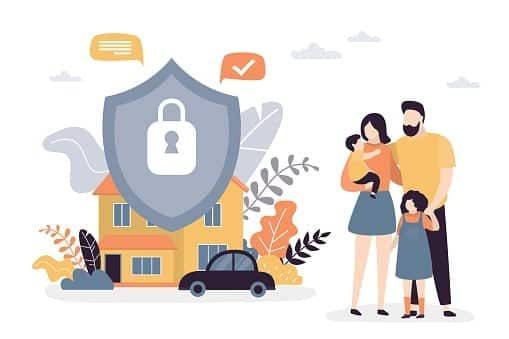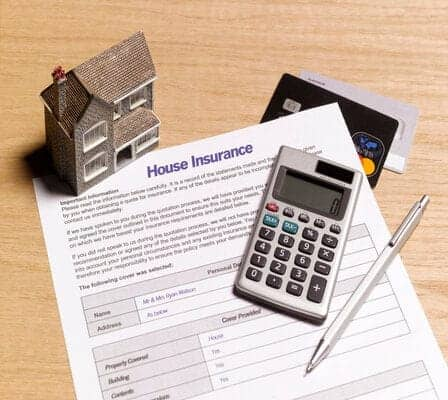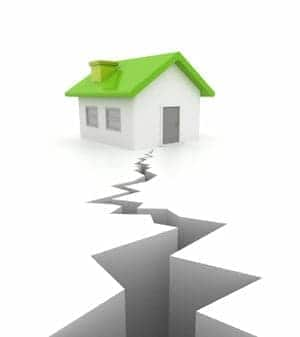What affects homeowners insurance premiums?
There are five main factors that affect the cost of home insurance. Within those categories, there are many smaller factors.
While most factors are beyond your control, there are some things you can change to reduce the cost of your homeowners insurance.
1. Replacement cost of your home
Replacement cost is the amount of money required to rebuild your home from the ground up, and on your policy, it makes up the dwelling coverage amount. This is different from a home's market value. Market value includes other things, such as the land's value.
Home insurance rates are affected most directly by the replacement cost of the home because it's often the largest coverage limit on the policy, and the one most likely to cost the insurance company in a claim.
It’s calculated based on many different factors about the home, including:
- Square footage. A bigger house costs more to rebuild.
- Construction type. Construction types differ in cost, and the risk in a fire is different, too, if you have a brick home vs. a wood home, for example.
- Features of the home. Fireplaces, crown molding, a jetted tub – features like these can increase reconstruction costs.
- Building materials. The materials used both inside and out, such as your siding and the material of your kitchen counters, affect the cost of rebuilding.
- The age of your home. Newly-constructed homes get an average 36% discount compared to other homes.
"It's possible that an older home may cost more to insure, as the materials [and] features in older homes can be more costly to repair and replace, things like plaster walls, ornate moldings, stained-glass windows [and] hardwood floors," Allstate spokesperson Justin Herndon says.
Janet Ruiz, a California representative for the Insurance Information Institute, says it's important that insurance buyers estimate the true cost of rebuilding their home if it should be damaged.
"Many insurance companies will have some kind of tool you can use and it will give you an approximate cost to rebuild," Ruiz says. "The second way is to check with a local contractor in your area to find out what the average building costs are. It's good to do both."
You won't be protected adequately if you don’t buy enough insurance. Adding extended replacement cost coverage can help avoid this.
"If you underinsure your place, you'll likely be in for a bad shock," warns William F. Harris, an independent insurance agent in Los Angeles. "Nobody wants that kind of surprise."
2. Risk factors in and around the home
Home insurance companies look at the risk of a claim being filed when calculating home insurance rates. What makes your home riskier to insure? What factors increase the likelihood of a larger claim being filed?
Every home has risk factors both inside and out, but some are more likely to have a big impact on your rates.
- The location of your home. Home insurance rates vary by state but also by ZIP code and even whether the home is in an urban, suburban or rural area.
- Your dog. Some insurers won't insure homeowners who own certain breeds of dogs considered dangerous, such as pit bulls and Rottweilers. Others decide on a case-by-case basis but may increase your rates for a dog considered a bite risk.
- Wood-burning stove or fireplace. Not surprisingly, having a wood fire in your house increases the risk of a fire claim.
- A swimming pool. The risk of someone drowning means higher insurance rates. A hot tub or pond on the property can have a similar impact.
- The age and condition of your roof. "The condition of the roof affects your homeowners policy. New/newer roofs will typically see a reduced premium, while homes with older roofs will pay more," Herndon says.
- Proximity to a body of water. While home insurance excludes flood damage, being close to the ocean increases the risk of hurricanes and other storms. Flood insurance can be purchased through the National Flood Insurance Program, which is run by the Federal Emergency Management Agency (FEMA).
- Proximity to a fire station. The closer you are to a fire station, the faster a fire in your home will be put out, reducing the risk of a major fire claim.
3. Risk factors specific to the homeowner
Although factors about you have less effect on home insurance rates than they do on your car insurance, there are some things related to the homeowner that affect the cost of homeowners insurance.
- Your credit history. In all states except California, Maryland and Massachusetts, insurance companies can use your credit history when determining home insurance rates. Insurance companies use an insurance score, which is not the same as a FICO credit score but uses some of the same information.
- Your marital status. Insurance companies see married people as more stable, more responsible and less likely to file a claim. "Sure, married people tend to get (financial) breaks, with their taxes and elsewhere," Harris says. "It just happens to be the same when it comes to a homeowners policy. It's really all about the claims numbers."
- A home-based business. Depending on the type of business, you may need to add an endorsement to your policy to protect business equipment as well as provide liability coverage.
4. The coverage on the policy
It’s a basic calculation: the more coverage you need, the more you can expect to pay. There are a few main types of coverage on a home insurance policy, and changes you make to those levels will impact your premium.
- Dwelling coverage. This is based on the reconstruction cost of your home, which we’ve already discussed above; it’s such an important factor that it earns its own category on this list. The higher your dwelling coverage, the more expensive your insurance will be.
- Liability limits. The standard coverage is $100,000, but experts recommend increasing that to $300,000. If you have assets above $500,000, you should see whether a separate umbrella policy would make sense for you.
- Personal property coverage. This is calculated as a percentage of the dwelling coverage, but you have the option to increase it. You can also choose replacement cost coverage rather than actual cash value coverage at an added cost.
- Deductible. A higher deductible means lower premiums since you’ll pay more out of pocket if there’s a claim and are less likely to file smaller claims.
- Add-on coverages. Home insurance policies offer a host of coverage options you can add, from sewer and water backup to floaters for high-value items. Adding more coverage means a higher premium.
5. Claims history
Claims history can impact your rates in more than one way.
"There's a significant correlation between claims that are made and future additional likelihood of claims being made," says Chris Hackett, senior director of personal lines policy at the Property Casualty Insurers Association of America.
Claims that can affect current rates on your home include:
- Your personal claims history. Even if it was at a different home, past claims you have filed could increase your rates.
- The home’s claims history. Claims filed in the past at your address can impact rates, even if you didn’t file them.
- The area’s claims history. A lot of claims for similar issues in the surrounding area can increase rates; for example, a lot of hail damage claims or claims for burglary.
How to save on homeowners insurance
All of the risk factors above combine to create high rates for some homes and lower for others. Some of these factors can be changed or influenced. Here’s what you can do to save on home insurance.
- Make improvements to the home. A new roof, storm shutters, hail-resistant siding - anything you can do to reduce the risk of an expensive claim can lower your rates.
- Add safety and security devices: Many insurance companies offer a discount for adding a burglar alarm, smoke detectors, fire extinguishers and other protective devices.
- Improve your credit. Your insurance score will go up along with your credit score, and your insurance rates will go down.
- Raise your deductible. You’ll get a lower rate in return; just make sure you can manage the amount if there’s a claim.
- Remove risk factors. Get rid of the trampoline, make sure you don’t have old appliances or broken-down cars on your property and anything else that insurance companies consider an “attractive nuisance” (in other words, a liability risk)
- Shop around. The easiest factor to change is your insurer. Not all insurance companies calculate rates the same way. Shop around and compare rates to get the best price.
Home insurance FAQs
Why is my home insurance so high, and what can I do about it?
There are a lot of reasons your rates are high; take a look through the factors above and see if you can identify the ones that apply to you. The best thing you can do to lower your rates is to shop around, regardless of the reason.
Is homeowners insurance negotiable?
No. Homeowners insurance rates are regulated by the state. While your insurance company can offer you discounts, you can't haggle on the rate.
Why does homeowners insurance increase every year?
Home insurance companies raise rates to keep up with inflation. Because the cost of rebuilding homes goes up, so do insurance rates. Claims paid in the previous year will also impact rates as insurance companies balance what they take in with what they pay out.






